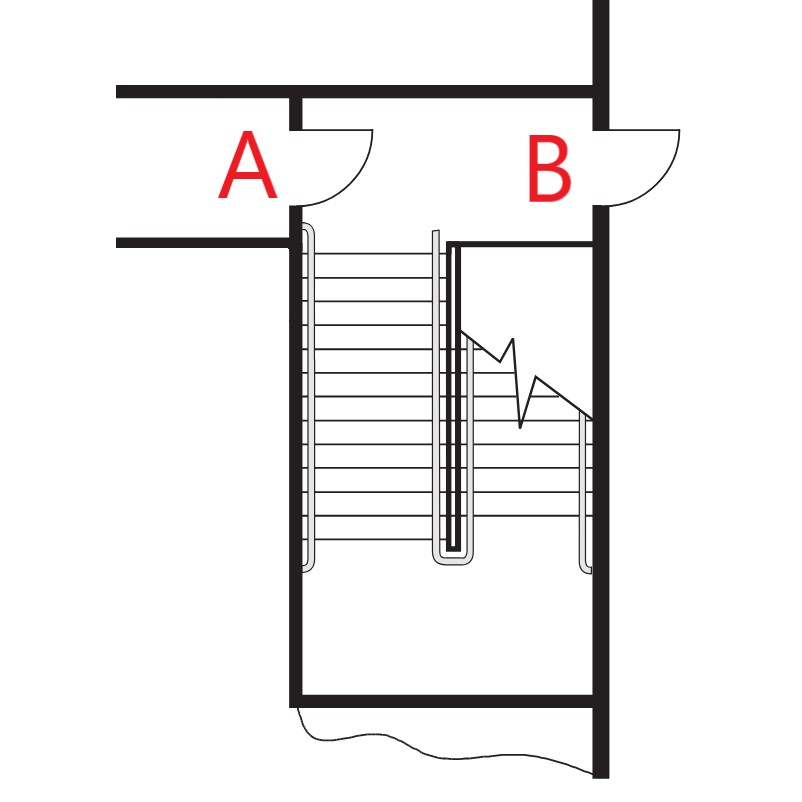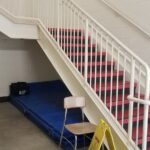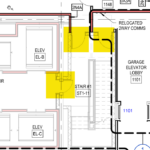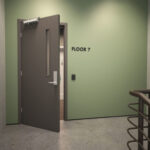Yesterday I posted a question about the remote unlocking of stairwell doors (please weigh in!), and today I have a follow-up question. Neither of these questions is specifically addressed in the model codes, so I am looking for any insight or experience from the field.
 As I mentioned yesterday, the code requirements related to stairwell reentry are intended to allow building occupants to leave a stairwell if the egress route becomes compromised during a fire. For example, if someone is evacuating from the 12th floor and reaches the 8th floor but finds it blocked by firefighters or filled with smoke, they can enter the 8th floor through a door that has been automatically unlocked. Once on the 8th floor, they can continue evacuating via another stairwell, or wait for assistance. The I-Codes require the remote unlocking of locked interior stairwell doors regardless of the number of floors served by the stairwell. And just to clarify – these doors are typically locked on the stairwell side – not on the egress side of the door leading into the stairwell.
As I mentioned yesterday, the code requirements related to stairwell reentry are intended to allow building occupants to leave a stairwell if the egress route becomes compromised during a fire. For example, if someone is evacuating from the 12th floor and reaches the 8th floor but finds it blocked by firefighters or filled with smoke, they can enter the 8th floor through a door that has been automatically unlocked. Once on the 8th floor, they can continue evacuating via another stairwell, or wait for assistance. The I-Codes require the remote unlocking of locked interior stairwell doors regardless of the number of floors served by the stairwell. And just to clarify – these doors are typically locked on the stairwell side – not on the egress side of the door leading into the stairwell.
Today’s question is this: On the ground floor of many stairwells, there is a stair discharge door as well as a door leading from the ground floor into the stair. The stair discharge door (Door B) allows free egress to the exterior of the building. In this situation, is the interior door that leads to the ground floor (Door A) required to be unlocked remotely on the stair side to allow reentry to the ground floor? If this door remained locked during a fire, building occupants would continue out the discharge door, but this question is not specifically addressed in the codes.
WWYD?
You need to login or register to bookmark/favorite this content.









I am not a high rise person
2018 ibc
403.5.3 Stairway Door Operation
Stairway doors other than the exit discharge doors shall be permitted to be locked from the stairway side. Stairway doors that are locked from the stairway side shall be capable of being unlocked simultaneously without unlatching upon a signal from the fire command center.
So if the question was in for a high rise building,,,, Yes, the interior door would have to remote unlock.
Hi Charles –
I agree that the code doesn’t differentiate between doors to upper floors and an interior door at the ground floor where there is also a discharge door. I would rather have people exit out rather than back into the building, but as you mentioned before, there is also firefighter access to consider.
– Lori
NFPA 101 (2018) 7.2.1.5.8* Every door assembly in a stair enclosure serving more than
four stories, unless permitted by 7.2.1.5.8.2, shall meet one of the following
conditions:
(1) Re-entry from the stair enclosure to the interior of the building
shall be provided.
(2) An automatic release that is actuated with the initiation of the
building fire alarm system shall be provided to unlock all stair
enclosure door assemblies to allow re-entry.
(3) Selected re-entry shall be provided in accordance with 7.2.1.5.8.1.
I always enjoy the articles, Lori. Thank you for putting so much thought and effort into the site! I work mainly out of the Life Safety Code and if the occupancy you’re describing is under its purview, and is more than 4 stories, then I would say that re-entry to the ground floor must be available. Under item (2) above we see the language “all stair enclosure door assemblies”
Thanks for sharing your insight, Clinton!
– Lori
I do not believe intent is for the exterior stairwell egress door to be part of this reentry language. It would be a really bad precedent to unlock the exterior stairwell door any time a fire alarm is triggered. There is no other location that requires you to unlock the exterior of the building on a fire alarm event or power outage. I work for a University and it would be very bad practice for a power outage or fire alarm to bypass any security to our dorms.
Hi Carl –
The stair discharge door is not required by the model codes to unlock upon fire alarm.
– Lori
The unlocking of stair doors also enables firefighter access to the floor, in addition to facilitating evacuation from the building. This enables firefighter access to adjacent floors if a fire spreads beyond the floor of origin. It also facilitates access to controls for building systems that might serve multiple floors.
Firefighters might need ground floor access from the stairwell back into the building interior where the fire control center is located, so the AHJ could want the interior stair door to be unlockable for reentry while fighting a fire immediately above the ground floor.
The need for unlocking at this door would appear to be driven by a need for firefighter access depending on the specific layout of the ground floor.
In our dorms, re-entry into the ground level is permitted due to the event that the exterior door could be blocked or compromised. The exterior door is access by a controlled means only. Occupants cannot re-enter until the building has been cleared.
In my opinion, the fire alarm system should not automatically unlock the doors when the fire alarm is activated. My interpretation of “1008.1.9.10 Stairway doors” paragraph 3 is that the doors must unlock “upon a signal from the fire command center, if present, or by a signal by emergency personnel from a single location inside the main entrance to the building”. I admit that I have never done a project where the fire alarm did not automatically unlock the stair towers doors. I think the paragraph was written for any emergency and not just a fire alarm.
Hi Alex –
You’re correct that the I-Codes did not require stair doors to automatically unlock upon fire alarm activation, but that changed with the 2024 editions: https://idighardware.com/2023/12/decoded-stairwell-reentry/.
– Lori